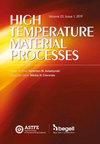偏置电压对直流双磁控溅射沉积Ti-Nb-C薄膜结构和力学性能的影响
IF 0.6
Q4 MATERIALS SCIENCE, MULTIDISCIPLINARY
引用次数: 0
摘要
采用直流磁控共溅射法制备了Ti+Nb复合材料Ti-Nb- c薄膜,并在Si衬底上施加-50÷-200 V范围内的负衬底偏压,制备了Ti-Nb- c薄膜。比较研究了薄膜的微观结构、化学键和力学性能。x射线衍射(XRD)分析表明,Ti+Nb复合靶材与石墨靶材共溅射得到的膜的XRD谱峰位于Ti- c和Nb- c膜对应峰之间的中间区域。x射线光电子能谱(XPS)表明,Ti-C和Nb-C键在沉积的Ti-Nb-C薄膜中占主导地位。结果表明,Ti-Nb-C薄膜是一种纳米复合材料,由TiC-NbC固溶体的结晶包裹在无定形碳基基体中。在衬底偏压为-50 V时,Ti-Nb-C薄膜的Knoop硬度最高(37.5 GPa)。在Ti-Nb-C薄膜中,分层前测定的平均摩擦系数最低(0.12)。本文章由计算机程序翻译,如有差异,请以英文原文为准。
INFLUENCE OF BIAS VOLTAGE ON THE STRUCTURE AND MECHANICAL PROPERTIES OF Ti-Nb-C FILMS DEPOSITED BY DC DUAL MAGNETRON SPUTTERING
The films of the Ti-Nb-C system were deposited by direct current (DC) magnetron co-sputtering of composite Ti+Nb, and graphite targets onto Si substrates to which negative substrate bias in the range of ‒50÷‒200 V was applied during film deposition. The microstructure, chemical bonds and mechanical properties of films were comparatively investigated. The X-ray diffraction (XRD) analysis revealed that the peaks of the XRD spectra of the film obtained by co-spattering of the composite Ti+Nb and graphite targets are located in intermediate region between the corresponding peaks of the Ti-C and Nb-C films. The X-ray photoelectron spectroscopy (XPS) showed that the Ti-C and Nb-C bonds prevail in the deposited Ti-Nb-C films. It was suggested that the Ti-Nb-C films are nanocomposite and consist of the crystallites of TiC-NbC solid solutions surrounded by amorphous carbon-based matrix. The Knoop hardness of the Ti-Nb-C film is highest (37.5 GPa) in the film deposited at ‒50 V substrate bias. The average friction coefficient determined before film delamination was the lowest (0.12) in that Ti-Nb-C film.
求助全文
通过发布文献求助,成功后即可免费获取论文全文。
去求助
来源期刊

High Temperature Material Processes
工程技术-材料科学:综合
CiteScore
1.20
自引率
25.00%
发文量
31
期刊介绍:
High Temperature Material Processes is an important international publication devoted to original and invited review papers on fundamental and applied re-search and new developments in materials processing and synthesis at high temperatures, especially under the plasma action as well as the treatment by laser, ion and electron beams. Processes of interest include (but not limited to) surface treatments, alloying, coatings production, nanostructures synthesis, welding, cutting, melting, re-melting and purification of metals, metallurgy (among them plasma metallurgy), powder densification, ultra-fine powder production, waste conversion and destruction. In addition, attention is paid to the development, description and study of experimental and industrial systems and devices for the implementation of high-technology plasma and beam processes. Thus, there is a broad range of coverage of experimental, analytical and numerical studies. High Temperature Material Processes will serve the needs of those who develop high temperature processes to produce materials with improved properties, surface treatments or coatings with given specifications, and will also promote connections between laboratories and industry.
 求助内容:
求助内容: 应助结果提醒方式:
应助结果提醒方式:


